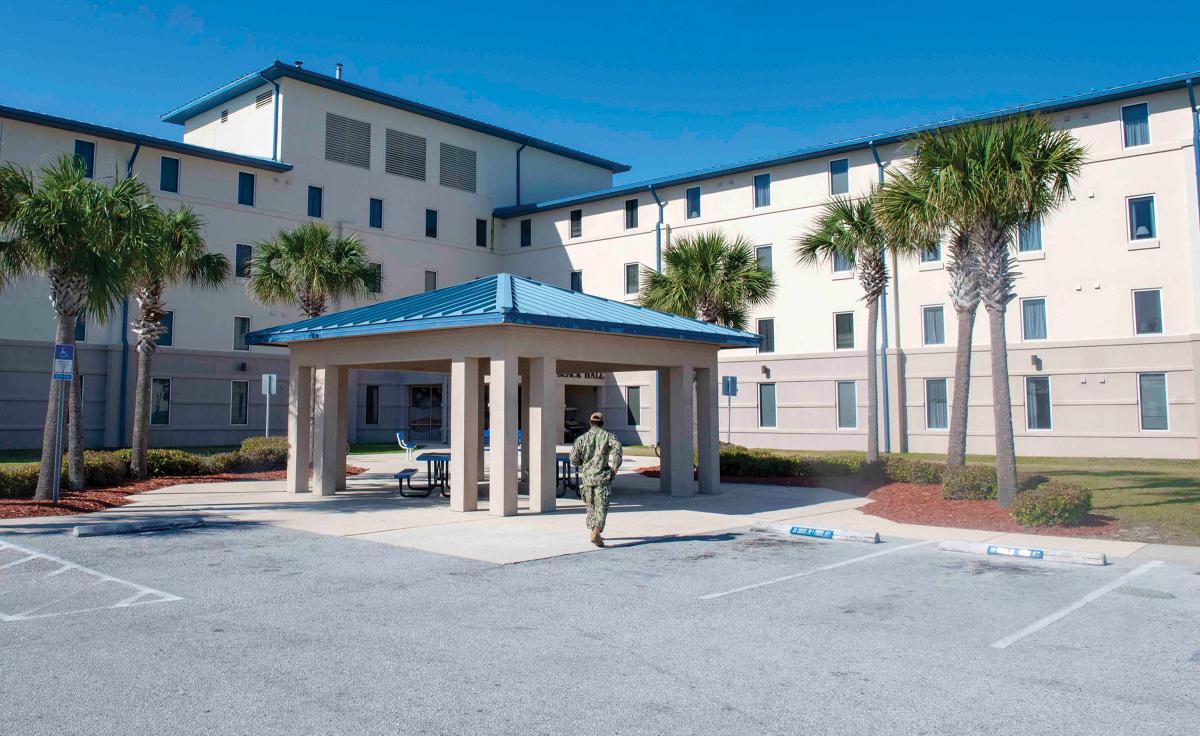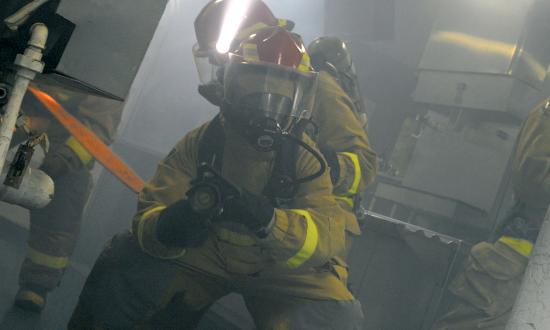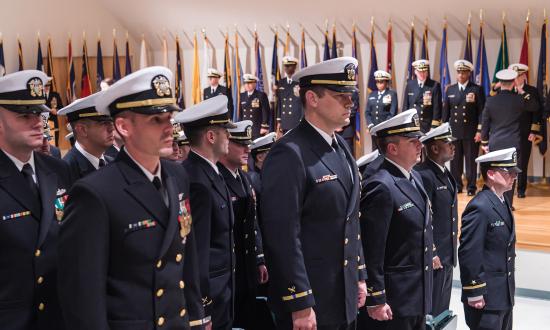We have all seen it. The triad is leading a command call for E-4 and below to ask how things are going. The floor is open for questions, concerns, and gripes. Seaman Smith says, “The barracks suck.” This elicits a chorus of “Yeahs!” and “Definitely!” However, this consensus fails to bring recommendations for any specific changes. Why is this? In part, it is because none of the junior enlisted know the levers available to make changes. There also is some resignation that the barracks will always suck—the barracks at their training commands sucked, and the “senior” E-4s insist they will always suck, quietly commenting in the back that it is a waste of time to complain.
We should not accept lousy barracks accommodations for junior enlisted as normal. The barracks is a huge component of junior enlisted sailors’ quality of life. It is where they will live ashore for most of their initial contracts, being eligible to move off-base and collect basic housing allowance only after being promoted to E-5 or with command approval after four years. Investing in sailors means taking care of where they live, and this could increase retention and mission buy-in. There are a handful of immediate changes the Navy can make, for relatively low cost.
Use Inspections to Monitor Barracks Conditions
One change would be to adapt an existing tool commands already use: the room inspection. Tenant commands are responsible for periodic inspections of their sailors’ quarters within unaccompanied housing. They currently focus on ensuring sailors adequately maintain their quarters, comply with regulations, and keep a hygienic environment. Commands should broaden inspections to monitor the barracks’ compliance as well: Inspect the common areas, laundry rooms, and other facilities to note deficiencies that hurt sailors’ standard of living. Some problems could be fixed with a phone call to the barracks staff or associated contractors, but others are more fundamental issues of building design requiring modernization.
“Health and comfort” inspections are a more intrusive option for examining tenants’ rooms, usually in search of contraband. These periodic sweeps could be broadened to the barracks common areas, such as lounges and laundry rooms, and give “hits” for washers out of service or broken air conditioning units. This system would promote accountability for the base barracks staff and contractors—a blind spot that was revealed by the push to improve base housing.
Another quick fix would be to automatically route a copy of a tenant’s trouble ticket (reporting a broken appliance or other discrepancy) to his or her command. This would serve as a quick reference for the chief of the boat or command master chief to identify any trends. It also would give the tenants’ commands leverage to resolve any outstanding issues. Junior enlisted personnel need to learn how to navigate the Navy’s layered systems and should take the lead in resolving problems. However, just knowing they were backed up by their chains of command would boost their confidence and ability to resolve the issues.
Another idea is for each command’s triad to spend two weekends in the barracks, one in the summer and one in the winter, to ensure the habitability of their sailors’ quarters. This would be a great monitoring opportunity for the triad; and the morale benefits of seeing the commanding officer/executive officer sharing a room would be enormous. This sort of sustained presence in the barracks would be much more informative than a walkthrough and could help build camaraderie.
Upgrade Substandard Facilities and Systems
Some issues junior enlisted face in the barracks require attention from an authority above that of the tenants’ commands. These issues would require either significant upgrades or renovations. The Navy must suppress the urge to splurge, as any renovation process must avoid the housing arms race that plagues colleges and drives up costs. A narrow focus on pressing issues will yield quicker results. The first issue is climate control, which is required per the Facilities Planning Criteria. Unfortunately, these criteria are unmet in many barracks, including at Bangor, Washington, where there is a lack of heating. The facility staff provided a small number of space heaters that personnel could check out, but not nearly enough for every room.
In Bremerton, Washington, every time fans came in stock, there was a proverbial line of ants as barracks tenants streamed up and down the hill to the Navy exchange, looking for a way to keep cool. A $20 expense is minor, but if every room needs a fan, it would make sense for the Navy to buy in bulk. Later, the base authorized a single type of swamp cooler, but only one model, which was not carried by the local exchange.
Although barracks are intentionally austere, having sailors suffer because of the weather prevents them from resting in their rooms and showing up for duty recharged and ready to work. Personal electronics can suffer heat damage and cost junior sailors a significant portion of their paychecks. Forcing junior enlisted to purchase fans or heaters for their barracks rooms is an occupational tax, in addition to regular expenses such as haircuts and uniform upkeep. Albeit a minor financial expense, it is a frustrating reminder that they have to supplement the government’s housing. The barracks multiply this frustration by specifying which models of fans and heaters can be purchased, instead of setting a broad policy as to appropriate household units. Prudent rules to prevent damage to the facilities are necessary, but authorizing basic household fans and heaters for individual use would go a long way toward investing in sailors in the barracks.
A single shared kitchen on the ground floor for hundreds of sailors across multiple boats directly impedes a sailor’s ability to eat healthy. Sailors begin drawing basic allowance for subsistence (BAS) as their ships lose habitability because of refit, or by rotating off the boat and into a home port training period on a two-crew submarine. This gives these sailors a little extra money—but they cannot eat at the on-base galley without paying, which can rapidly deplete their BAS.
Individual commands and regional Morale, Recreation, and Welfare Centers give great cooking classes emphasizing cheap, healthy, and simple meals, but with only a handful of sailors able to cook at a time, it is difficult to put these skills into practice in the barracks. Sailors end up eating mostly cereals and microwave meals. Lacking a dishwasher, sailors eat off paper plates, taking out the trash each morning on the way to the boat. Incorporating a sailor-to-appliance ratio into barracks requirements—for example, converting one room per floor into a common kitchen would make cooking more accessible.
Limited access to mail also can impede sailors’ ability to do everyday activities. Often, sailors must either rent P.O. boxes in town or send their mail to their command. Walking from the boat or across base to retrieve a magazine is simple enough, but ordering packages for delivery and then hauling them three-quarters of a mile is significantly less appealing. It also restricts sailors’ ability to pick up their mail, because they must either find time during the workday to get to and from the post office or rely on the military mail system, which can experience delays. Many sailors just ask senior members of their divisions who live off-base if they can use their addresses for mail, and then bring any mail to quarters the next morning. This workaround is common and low-cost, but should not be necessary.
Sailors Deserve a Better Quality of Life
Single sailors in the barracks are younger, lower ranking, and have fewer avenues to redress their grievances. It is easy to write off the complaints from the barracks as “the usual gripes,” but it is important to remember that this is where our sailors live. The Navy rightly sets standards for sailors living in housing, but those making the policies need to draw a distinction between policies governing behavior and unintentional obstacles that make everyday living more complicated. At worst, these obstacles undermine the military’s goals for these junior sailors: small laundry facilities with few working machines undermine a clean appearance and hygienic clothing; restricted access to cooking stymies healthy, cheap eating, instead incentivizing microwave meals and eating out; and poor access to mail prevents many activities, from getting packages, to absentee voting, to receiving a letter from home.
The recent push to renovate on-base housing for families is proof that sustained attention and accountability can result in major changes in living conditions. The Navy must extend this effort to the barracks.






